Keeping flies off of you can be a real challenge, especially during outdoor activities. This article from flyermedia.net explores practical and effective strategies to keep flies away, ensuring your comfort and peace of mind. Discover how to repel flies using simple methods, natural deterrents, and innovative solutions for a fly-free environment.
Flies are not only annoying but can also pose health risks. In this comprehensive guide, we will delve into various methods, including the popular penny trick, essential oil blends, and advanced fly control technologies, to help you maintain a fly-free zone. Let’s dive in and discover the best ways to repel those pesky flies.
1. Understanding Why Flies Are Attracted to You
Before diving into solutions, it’s essential to understand why flies are attracted to you in the first place. Several factors can contribute to this attraction, including body odor, sweat, and even the clothes you wear.
1.1 Body Odor and Sweat
Flies are highly sensitive to odors, and the natural scents produced by our bodies can be incredibly attractive to them. Sweat, in particular, contains lactic acid, ammonia, and other compounds that flies find irresistible. According to research published in the Journal of Insect Physiology, flies can detect these odors from a considerable distance, making it essential to manage body odor to reduce fly attraction.
1.2 Clothing Color and Material
The color and material of your clothing can also play a role. Dark colors, such as black and navy blue, tend to absorb more heat, which can increase body temperature and, consequently, sweat production. Additionally, certain materials may trap more moisture, creating a favorable environment for flies. Lighter, breathable fabrics are generally better at keeping you cool and less attractive to flies.
1.3 Environmental Factors
Environmental factors such as nearby food sources and standing water can significantly increase the presence of flies. If you are in an area with abundant decaying matter or stagnant water, flies will naturally be drawn to the vicinity, increasing the likelihood of them landing on you.
1.4 Carbon Dioxide
Flies, like mosquitoes, are attracted to carbon dioxide (CO2), which humans exhale. This is one of the primary ways they locate potential hosts. The amount of CO2 a person emits can vary based on their size, activity level, and metabolic rate, making some individuals more attractive to flies than others.
2. Effective DIY Methods to Keep Flies Away
Fortunately, there are several do-it-yourself (DIY) methods that can help keep flies off of you. These methods are often inexpensive, easy to implement, and utilize common household items.
2.1 The Penny Trick: Myth or Reality?
One popular method is the “penny trick,” which involves placing pennies in a glass or bag of water. The idea is that the reflection of light off the water and pennies disorients flies, causing them to stay away.
How to Use Pennies in Water to Repel Flies:
- Method 1: Pennies in a Glass of Water
- Fill several clear glasses with water.
- Place 4-5 pennies at the bottom of each glass.
- Position the glasses around your outdoor dining or seating area.
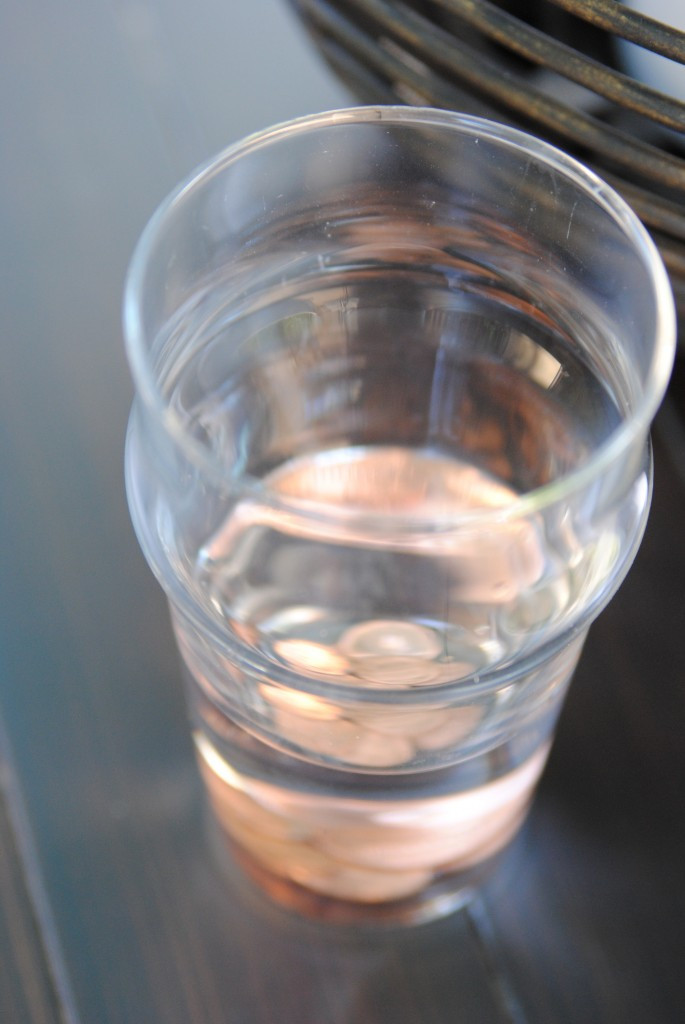 A full glass of water with pennies at the bottom to deter flies
A full glass of water with pennies at the bottom to deter flies
- Method 2: Pennies in a Bag of Water
- Fill a resealable plastic bag (sandwich or quart-sized) about ¾ full with water.
- Drop 4-5 pennies into the bag.
- Seal the bag tightly, ensuring the pennies are spread out.
- Hang the bag in areas where you want to repel flies.
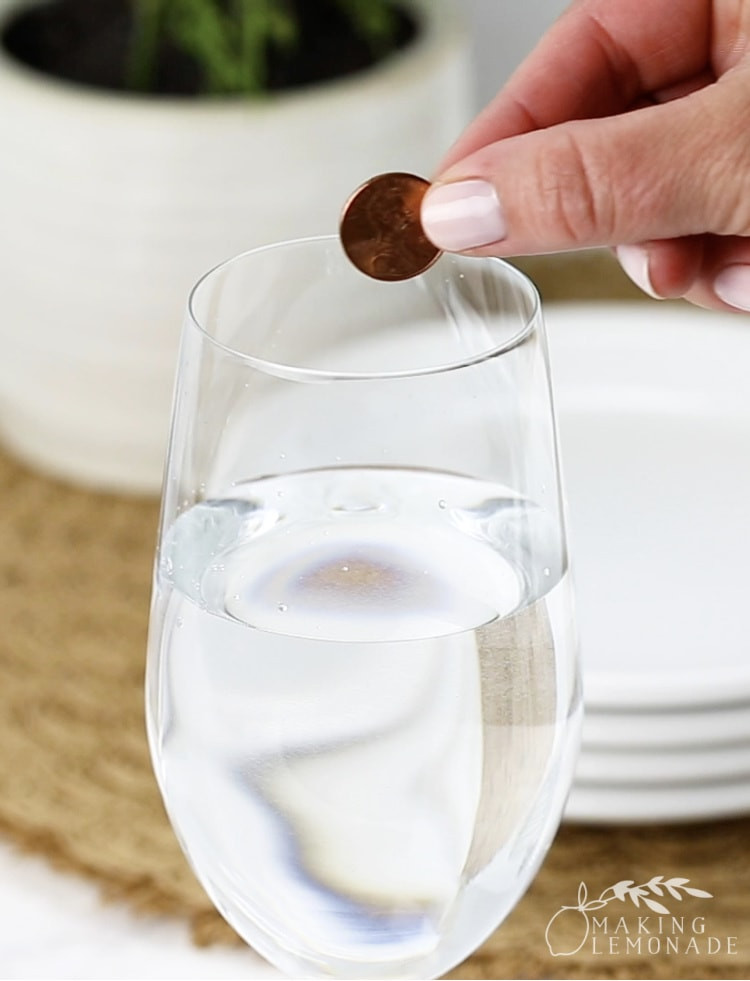 Dropping a penny in a full glass of water to keep flies away
Dropping a penny in a full glass of water to keep flies away
While anecdotal evidence suggests the penny trick can be effective, scientific evidence supporting its efficacy is limited. Some experts believe the reflective properties of the water and pennies may deter flies, while others remain skeptical.
2.2 Homemade Fly Sprays
Creating your own fly repellent sprays is another effective DIY method. These sprays often utilize natural ingredients that flies find offensive.
DIY Fly Spray Recipe:
- Ingredients:
- 1 cup of water
- 1 tablespoon of dish soap
- 10-15 drops of essential oils (e.g., peppermint, lavender, eucalyptus)
- Instructions:
- Mix all ingredients in a spray bottle.
- Shake well before each use.
- Spray around your body and outdoor area, avoiding direct contact with eyes and skin.
2.3 Vinegar Traps
Vinegar traps are another simple yet effective way to control flies. Flies are attracted to the sweet and sour scent of vinegar, and once they enter the trap, they are unable to escape.
DIY Vinegar Trap:
- Materials:
- A jar or plastic bottle
- Apple cider vinegar
- Dish soap
- Plastic wrap or a cone-shaped paper
- Instructions:
- Pour apple cider vinegar into the jar, filling it about ¼ full.
- Add a few drops of dish soap. The soap breaks the surface tension of the vinegar, causing flies to drown.
- Cover the jar with plastic wrap and secure it with a rubber band. Poke a few small holes in the plastic wrap. Alternatively, create a cone-shaped paper funnel and place it into the jar’s opening.
- Place the trap in areas where flies are prevalent.
 A bag of water hung up to repel flies, creating a fly-free zone
A bag of water hung up to repel flies, creating a fly-free zone
3. Essential Oils: Natural Fly Repellents
Essential oils offer a natural and aromatic way to repel flies. Many essential oils have insect-repelling properties and can be used in various ways to keep flies away.
3.1 Best Essential Oils for Repelling Flies
- Peppermint Oil: Peppermint oil is a potent insect repellent due to its strong scent. Flies, mosquitoes, and other insects dislike the smell, making it an effective deterrent.
- Lavender Oil: Lavender oil is not only known for its calming properties but also its ability to repel flies and moths.
- Eucalyptus Oil: Eucalyptus oil contains cineole, a compound that has insecticidal properties. It’s effective against a wide range of insects, including flies.
- Citronella Oil: Citronella oil is widely used in insect repellents, particularly for mosquitoes. It’s also effective against flies and other biting insects.
- Clove Oil: Clove oil has strong insecticidal properties and can be used to repel flies.
- Tea Tree Oil: Tea tree oil has antiseptic and insecticidal properties, making it a versatile option for repelling flies.
3.2 How to Use Essential Oils to Repel Flies
- Diffusers: Using an essential oil diffuser is an excellent way to fill an outdoor area with insect-repelling scents. Add a few drops of your chosen essential oil to the diffuser and let it run.
- Sprays: Create a simple essential oil spray by mixing 10-15 drops of essential oil with water in a spray bottle. Shake well and spray around your body and outdoor space.
- Cotton Balls: Soak cotton balls in essential oil and place them in areas where flies are common, such as near doors and windows.
- Topical Application: Mix a few drops of essential oil with a carrier oil (such as coconut or jojoba oil) and apply it to your skin. Always do a patch test first to ensure you don’t have an allergic reaction.
4. Plants That Repel Flies Naturally
Certain plants have natural insect-repelling properties. Incorporating these plants into your garden or outdoor area can help keep flies away.
4.1 Best Plants for Repelling Flies
- Basil: Basil is a popular herb that repels flies and mosquitoes. It contains compounds that insects find offensive.
- Lavender: As mentioned earlier, lavender not only smells great to humans but also repels flies, moths, and other insects.
- Rosemary: Rosemary is another herb with insect-repelling properties. It’s particularly effective against flies and cabbage moths.
- Mint: Mint is a versatile plant that repels flies, mosquitoes, and ants.
- Citronella Grass: Citronella grass is the source of citronella oil and is highly effective at repelling mosquitoes and flies.
- Marigolds: Marigolds contain pyrethrum, an insecticide compound that repels a variety of insects, including flies.
4.2 How to Use Plants to Repel Flies
- Planting: Plant these herbs and plants around your garden, patio, or outdoor seating area.
- Potted Plants: Place potted plants near doors, windows, and other entry points to create a natural barrier against flies.
- Dried Herbs: Hang dried herbs in muslin bags or scatter them around your outdoor space.
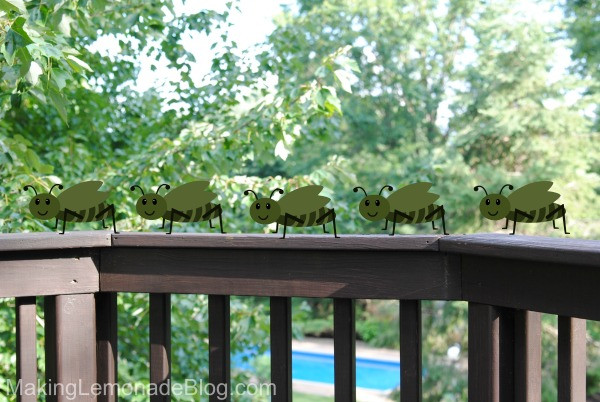 Clip art of flies on a balcony , emphasizing the need for effective fly control
Clip art of flies on a balcony , emphasizing the need for effective fly control
5. Professional Fly Control Methods
For severe fly infestations or situations where DIY methods are insufficient, professional fly control services may be necessary.
5.1 Fly Traps
Fly traps come in various forms, including sticky traps, light traps, and bait traps. These traps are designed to attract and capture flies, reducing their population.
- Sticky Traps: These traps are coated with a sticky adhesive that traps flies upon contact. They are often placed near windows and other areas where flies are common.
- Light Traps: Light traps use ultraviolet (UV) light to attract flies, which are then electrocuted or trapped on a sticky surface.
- Bait Traps: Bait traps contain a lure that attracts flies, which then enter the trap and are unable to escape.
5.2 Insecticides
Insecticides are chemical compounds designed to kill insects. They come in various forms, including sprays, granules, and baits.
- Sprays: Insecticide sprays can be used to treat areas where flies are common, such as around garbage bins and outdoor surfaces.
- Granules: Insecticide granules can be scattered around your yard to kill fly larvae in the soil.
- Baits: Insecticide baits contain a lure that attracts flies, which then consume the insecticide and die.
5.3 Professional Pest Control Services
Professional pest control services offer comprehensive fly control solutions, including identification of fly species, assessment of infestation levels, and implementation of targeted treatment plans. These services often use a combination of methods, including traps, insecticides, and environmental modifications, to effectively control fly populations.
6. Creating a Fly-Free Zone: Practical Tips
In addition to the methods mentioned above, there are several practical tips you can implement to create a fly-free zone around your home and outdoor area.
6.1 Maintain Cleanliness
Flies are attracted to filth and decaying matter. Keeping your home and outdoor area clean is essential for preventing fly infestations.
- Regular Cleaning: Clean your kitchen, bathrooms, and other areas regularly to remove food debris and spills.
- Garbage Disposal: Keep garbage bins tightly sealed and dispose of garbage regularly.
- Pet Waste: Clean up pet waste promptly to prevent flies from breeding.
- Drainage: Ensure proper drainage to prevent standing water, which can attract flies.
6.2 Proper Food Storage
Proper food storage is crucial for preventing flies from accessing food sources.
- Sealed Containers: Store food in airtight containers to prevent flies from getting to it.
- Covered Dishes: Cover dishes when eating outdoors to prevent flies from landing on your food.
- Prompt Cleanup: Clean up food spills and crumbs immediately.
6.3 Use Screens and Netting
Screens and netting can create a physical barrier that prevents flies from entering your home and outdoor area.
- Window Screens: Install screens on windows and doors to keep flies out.
- Mosquito Netting: Use mosquito netting around outdoor seating areas to create a fly-free zone.
- Food Tents: Use food tents to cover dishes when eating outdoors.
 A child eating at a picnic table, protected from flies by the surrounding environment
A child eating at a picnic table, protected from flies by the surrounding environment
7. Understanding Fly Species and Their Habits
Different fly species have different habits and preferences. Understanding the specific types of flies you are dealing with can help you tailor your control methods.
7.1 Common Fly Species
- House Flies (Musca domestica): House flies are one of the most common fly species. They are attracted to garbage, decaying matter, and food waste.
- Fruit Flies (Drosophila melanogaster): Fruit flies are attracted to ripe and fermenting fruits and vegetables.
- Drain Flies (Psychodidae): Drain flies breed in drains and sewers, feeding on organic matter.
- Blow Flies (Calliphoridae): Blow flies are attracted to decaying flesh and carrion.
7.2 Fly Breeding Habits
Flies lay their eggs in decaying matter, garbage, and other organic materials. Understanding their breeding habits can help you target their breeding sites and prevent fly infestations.
- Eliminate Breeding Sites: Remove garbage, decaying matter, and standing water from your property to eliminate fly breeding sites.
- Clean Drains: Clean drains regularly to prevent drain flies from breeding.
- Compost Management: Manage compost piles properly to prevent flies from breeding.
8. The Role of Fly Light Traps in Fly Control
Fly light traps are a modern and effective way to control flies, particularly in indoor environments. These traps use ultraviolet (UV) light to attract flies, which are then either electrocuted or captured on a sticky surface.
8.1 How Fly Light Traps Work
Fly light traps emit UV light, which is highly attractive to flies. When flies approach the light, they are either electrocuted by a high-voltage grid or trapped on a sticky glue board.
8.2 Types of Fly Light Traps
- Electric Fly Zappers: These traps use a high-voltage grid to electrocute flies.
- Glue Board Traps: These traps use a sticky glue board to capture flies.
8.3 Placement of Fly Light Traps
Proper placement of fly light traps is crucial for their effectiveness. They should be placed in areas where flies are common, such as near doors, windows, and food preparation areas.
9. The Science Behind Fly Vision and Attraction
Understanding how flies perceive the world can provide insights into why certain methods are effective at repelling them.
9.1 Fly Vision
Flies have compound eyes, which are made up of thousands of individual lenses. This gives them a wide field of vision and the ability to detect movement quickly. However, their vision is not as sharp as human vision.
9.2 Attraction to Light
Flies are attracted to ultraviolet (UV) light, which is why fly light traps are effective. They are also attracted to certain colors and patterns.
9.3 Odor Perception
Flies have highly sensitive olfactory receptors that allow them to detect odors from a considerable distance. They are attracted to a wide range of odors, including those from food, garbage, and decaying matter.
10. Addressing Common Myths About Fly Control
There are several common myths about fly control that can lead to ineffective strategies.
10.1 Myth: Flies Are Only a Problem in the Summer
While flies are more active in the summer, they can be a problem year-round, particularly in warmer climates.
10.2 Myth: Cleaning Is Enough to Prevent Flies
While cleanliness is essential, it is not always enough to prevent flies. Flies can enter your home through small cracks and openings, and they can breed in areas that are difficult to clean.
10.3 Myth: All Fly Sprays Are Safe
Not all fly sprays are safe for humans and pets. Always read the label carefully and follow the instructions. Consider using natural and non-toxic fly control methods whenever possible.
11. Innovative Technologies in Fly Control
Modern technology has led to the development of innovative fly control solutions.
11.1 Automated Fly Control Systems
Automated fly control systems use sensors and dispensers to automatically release insecticides or repellents at regular intervals.
11.2 Biological Control Methods
Biological control methods involve using natural predators or parasites to control fly populations.
11.3 Genetic Control Methods
Genetic control methods involve modifying the genes of flies to reduce their ability to reproduce.
12. Creating Long-Term Fly Control Strategies
Long-term fly control requires a comprehensive approach that addresses the root causes of fly infestations.
12.1 Integrated Pest Management (IPM)
Integrated Pest Management (IPM) is a holistic approach to pest control that involves using a combination of methods to prevent and control pests.
12.2 Environmental Modifications
Environmental modifications involve making changes to your property to reduce fly breeding sites and attractants.
12.3 Regular Monitoring
Regular monitoring is essential for detecting fly infestations early and implementing control measures promptly.
13. Fly Control for Specific Environments
Different environments may require different fly control strategies.
13.1 Fly Control for Homes
For homes, focus on cleanliness, proper food storage, and the use of screens and netting.
13.2 Fly Control for Restaurants
For restaurants, implement strict sanitation practices, use fly light traps, and consider professional pest control services.
13.3 Fly Control for Farms
For farms, manage manure properly, use biological control methods, and consider automated fly control systems.
14. The Impact of Climate Change on Fly Populations
Climate change is expected to have a significant impact on fly populations.
14.1 Increased Fly Activity
Warmer temperatures can increase fly activity and breeding rates.
14.2 Expanded Fly Ranges
Climate change may allow flies to expand their ranges into new areas.
14.3 Increased Disease Transmission
Climate change may increase the risk of fly-borne diseases.
15. Staying Safe While Using Fly Control Products
When using fly control products, it is essential to prioritize safety.
15.1 Reading Labels
Always read the label carefully before using any fly control product.
15.2 Following Instructions
Follow the instructions on the label carefully.
15.3 Using Protective Gear
Wear protective gear, such as gloves and masks, when using fly control products.
16. Case Studies: Successful Fly Control Strategies
Examining successful fly control strategies can provide valuable insights and inspiration.
16.1 Case Study 1: A Restaurant’s Fly Control Success
A restaurant implemented a comprehensive fly control program that included strict sanitation practices, fly light traps, and regular pest control services.
16.2 Case Study 2: A Farm’s Fly Control Success
A farm implemented a biological control program that involved using natural predators to control fly populations.
16.3 Case Study 3: A Homeowner’s Fly Control Success
A homeowner implemented a combination of DIY methods, including essential oil sprays and vinegar traps, to control flies in their home.
17. Common Mistakes to Avoid in Fly Control
Avoiding common mistakes can help you achieve more effective fly control.
17.1 Neglecting Breeding Sites
Failing to eliminate fly breeding sites can undermine your control efforts.
17.2 Using Ineffective Methods
Using ineffective methods can waste time and money.
17.3 Failing to Monitor Fly Populations
Failing to monitor fly populations can allow infestations to grow unchecked.
18. Resources for Further Learning
There are many resources available for further learning about fly control.
18.1 Websites
Websites such as flyermedia.net offer valuable information about fly control.
18.2 Books
Books on pest control can provide detailed information about fly control strategies.
18.3 Local Extension Offices
Local extension offices can provide advice and resources on fly control.
19. Conclusion: Achieving a Fly-Free Life
Keeping flies off of you requires a combination of strategies, including DIY methods, essential oils, plants, professional services, and practical tips. By understanding why flies are attracted to you and implementing effective control measures, you can enjoy a fly-free life.
Remember, maintaining cleanliness, proper food storage, and regular monitoring are essential for long-term fly control. Explore the resources available at flyermedia.net to further enhance your knowledge and strategies for dealing with flies.
20. Frequently Asked Questions (FAQs) About Keeping Flies Away
20.1 What is the most effective way to keep flies away from me?
The most effective way involves a combination of methods, including using essential oil-based repellents, wearing appropriate clothing, and maintaining cleanliness in your surroundings.
20.2 Do essential oils really repel flies?
Yes, certain essential oils like peppermint, lavender, eucalyptus, and citronella are known to repel flies effectively. You can use them in diffusers or create your own spray.
20.3 Does the penny in a water bag trick really work to repel flies?
Anecdotal evidence suggests it might, but scientific evidence is limited. The idea is that the reflection of light disorients flies.
20.4 What plants can I use to keep flies away naturally?
Basil, lavender, rosemary, mint, and citronella grass are all effective plants that can help repel flies naturally.
20.5 How can I prevent flies from entering my home?
Use screens on windows and doors, seal any cracks or openings, and maintain cleanliness to prevent flies from entering your home.
20.6 Are there any traps I can use to catch flies indoors?
Yes, sticky traps, light traps, and bait traps are all effective options for catching flies indoors.
20.7 What attracts flies to my yard?
Flies are attracted to garbage, decaying matter, pet waste, and standing water. Eliminate these attractants to reduce fly populations.
20.8 How often should I clean my garbage bins to prevent flies?
Clean your garbage bins regularly, ideally once a week, to prevent flies from breeding.
20.9 What should I do if I have a severe fly infestation?
For severe infestations, consider contacting a professional pest control service for comprehensive fly control solutions.
20.10 Can climate change affect fly populations?
Yes, climate change can increase fly activity, expand their ranges, and potentially increase the risk of fly-borne diseases.
Address: 600 S Clyde Morris Blvd, Daytona Beach, FL 32114, United States.
Phone: +1 (386) 226-6000.
Website: flyermedia.net.
Ready to take control of your environment and enjoy a fly-free life? Visit flyermedia.net today to explore more tips, resources, and expert advice on fly control and aviation. Whether you’re looking for effective DIY methods, the latest news in the aviation industry, or career opportunities in aviation, flyermedia.net has everything you need to elevate your experience. Don’t let flies ruin your day—discover the solutions that await you at flyermedia.net now.
 Amazing Trick for Repelling Flies at your next outdoor picnic or party using just THREE common household items through flyermedia.net
Amazing Trick for Repelling Flies at your next outdoor picnic or party using just THREE common household items through flyermedia.net
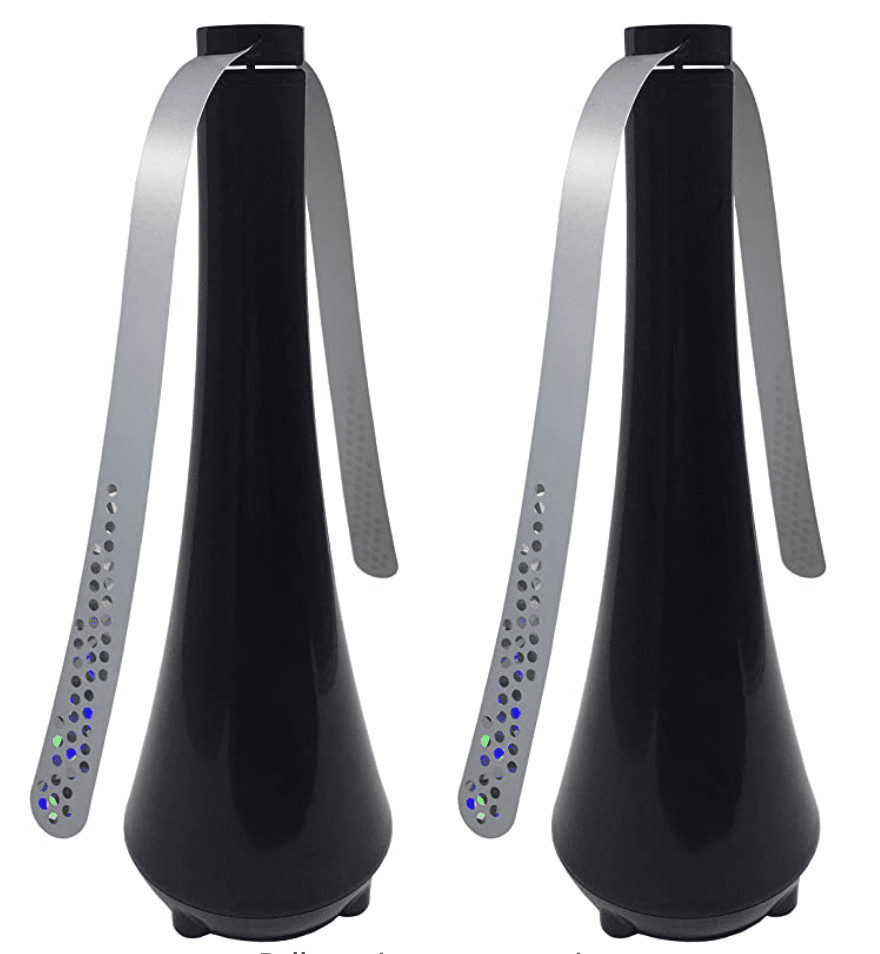 battery operated fans for getting rid of flies outdoors, demonstrating a modern approach
battery operated fans for getting rid of flies outdoors, demonstrating a modern approach
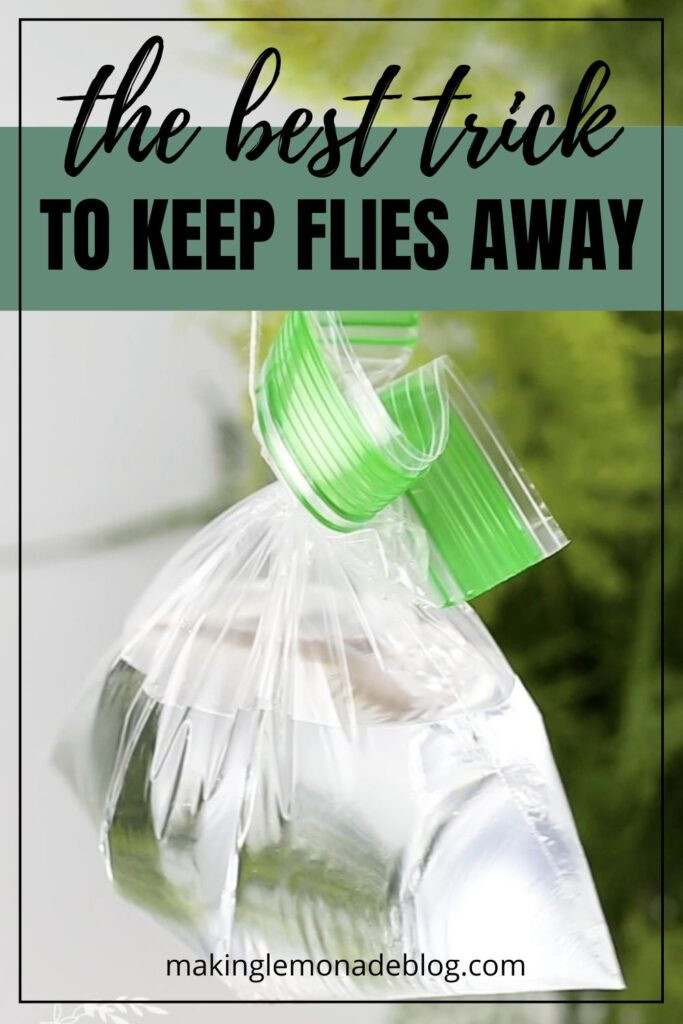 keep flies away using essential oils, a natural and aromatic fly control solution
keep flies away using essential oils, a natural and aromatic fly control solution